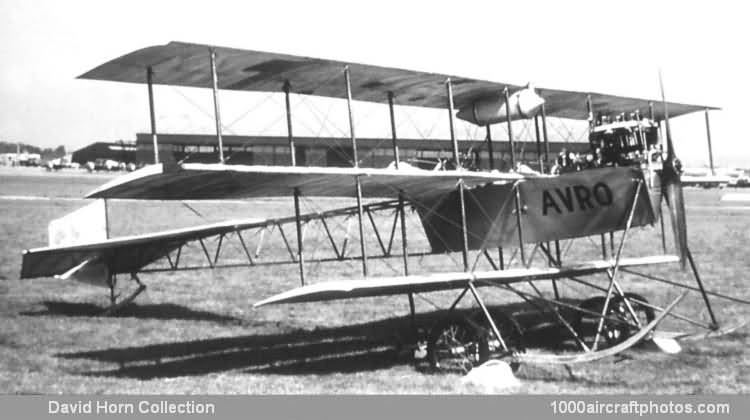03/31/2013. Remarks by Johan Visschedijk: "The last of Alliot Verdon Roe's primitive triplanes, completed in September 1910, was a single-seater structurally similar to its predecessors and powered by a 35 hp Green liquid-cooled engine, the radiator for which was mounted in the center section gap. The shortened bottom wing was retained but the wing chord was somewhat reduced.
Despite the improved lateral control given by ailerons, the Roe IV Triplane reverted to wing warping, effected by rotating a control wheel mounted on a column which moved fore and aft for diving and climbing. The tail plane was triangular in shape and for the first time of the non-lifting monoplane type equipped with movable elevators. The familiar four wheeled landing gear of the previous triplanes was also a feature of Roe IV.
By the middle of 1910 Alliot Verdon was fast becoming interested in building a biplane, with the result that only one Roe IV was constructed. It was used almost exclusively for instructional work at the Avro Flying School at Brooklands where pupils found it rather sensitive on the controls and more difficult to master than the earlier machines.
Needless to say it was broken many times as on October 10, 1910 when, in the words of an onlooker, "a pupil rose unsteadily and after 225 yards (206 m) slowly side-slipped into the sewage farm, completely smashing the starboard mainplane". Such incidents were so frequent that they excited little comment and the aircraft structure was so simple that even major damage could often be put right the same day.
Several famous pilots were trained on the Roe IV triplane, including Hubert Oxley and C. Howard Pixton, the former starting his training with a flourish by attempting to take off downwind without previous experience and nosing over in the sewage farm on October 17, 1910. Pixton, practicing figure eights at 200 ft (61 m) on November 8 for his Royal Aero Club certificate, side-slipped the Roe IV into the ground, where it caught fire and suffered extensive damage.
Nevertheless the machine was out again on November 17, back in the sewage farm by December 4 and carried Pixton successfully through the tests for his aviator's certificate on January 24, 1911. It continued to suffer at the hands of trainees such as F. Conway Jenkins, Gordon Bell, R.C. Kemp and Lt. W.D. Beatty, until the last mentioned slipped in and badly wrecked it on February 14, 1911. This time the damage took a fortnight to repair and the opportunity was taken to insert a four foot extension piece into the fuselage.
Pixton made the first test flight in the revised Roe IV on March 1 and managed to coax it up to 750 ft (229 m). This performance contrasted sharply with the usual 150 ft (46 m) ceiling associated with this machine. A week later on March 8, engine trouble compelled R.C. Kemp to abandon the tests for his certificate and soon afterwards (certainly no later than August 1911) the Roe IV was dismantled and replaced at the Avro School by the Type D biplane of superior performance.
The above pictured replica was resembling the rebuild Roe IV of 1911. The Hampshire Aeroplane Club of Eastleigh built this replica in 1964 for the well-known movie "Those Magnificent Men in Their Flying Machines" of 1965. It has been given the British Aircraft Preservation Council number BAPC.1 and is presently preserved in airworthy condition at the Shuttleworth Collection at Shuttleworth (Old Warden) Aerodrome, near Biggleswade, UK."
